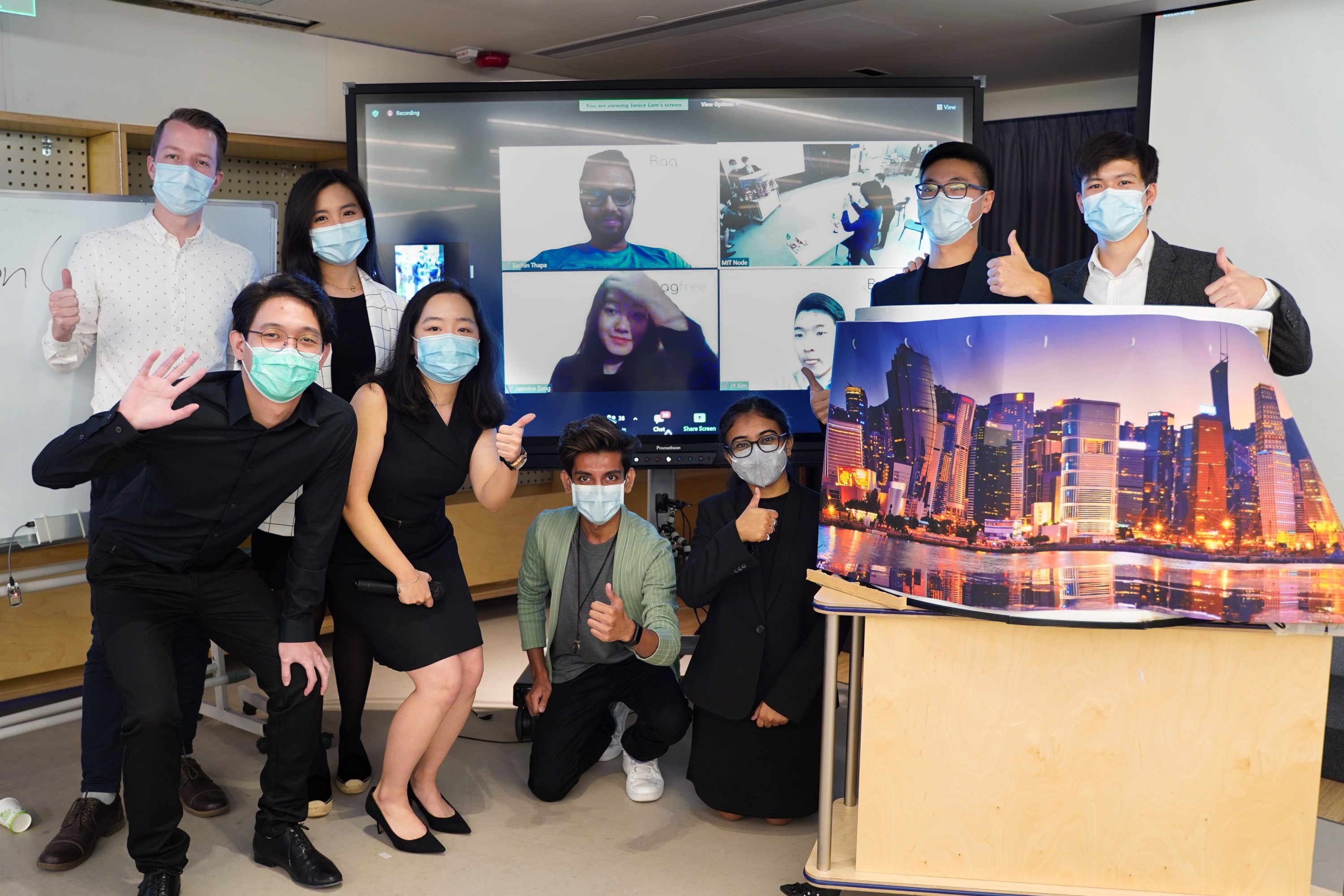Innovation for aviation
MIT students collaborate online with international peers to tackle business challenges for the Hong Kong International Airport.

The new normal has set in motion a sustained urgency to re-imagine how we learn, how we engage in teamwork, and how to solve real-world problems collaboratively. For the Entrepreneurship and Maker Skills Integrator (MEMSI), the MIT Hong Kong Innovation Node’s flagship hardware systems entrepreneurship program, what was originally designed as a two-week residential experience held during Independent Activities Period in Hong Kong shifted gears to hybrid mode.
This hybrid learning format was “a real experiment for us,” says Charlie Sodini, the Clarence J. LeBel Professor in Electrical Engineering and faculty director of the Innovation Node. “The opportunity for online and offline learning enabled the program to receive the largest number of students from MIT and from universities across Hong Kong in its eighth cohort.”
MEMSI’s industry theme struck home what many miss: air travel. Hampered by the pandemic, the partnership with the Airport Authority of Hong Kong was a unique opportunity to explore new innovations for the airport. During the program, students worked with industry mentors and domain experts to create solutions to improve the end-to-end passenger experience, optimize business operations, and develop digital marketing strategies and revenue streams for the Hong Kong International Airport.
The program leveraged the different Covid-19 protocols across geographic jurisdictions. While makerspace access on campus was off-limits in January, MIT students were able to collaborate online, shaping the design and development of the physical prototype as they worked with Hong Kong peers able to access the node’s makerspace.
With the flexibility to run sessions online, the node brought in more mentors and coaches to support each team. Tapping into the MIT alumni network in Hong Kong, the program featured experts across airport, airline, startup, and academic circles to help students deepen their understanding of the industry and how to use data-driven insights to inform their solutions.
Virtual immersion
A key component of MEMSI has historically been the cross-border field trip to visit one of the global centers of hardware innovation, Shenzhen, China. With travel restrictions in place, students in Hong Kong embarked on an eagerly-awaited visit to the Hong Kong International Airport, with special access to see ground operations, including the e-Security Gate, the baggage handling facility, and the airport apron. The three-hour tour was recorded on video, enabling MIT students to immerse in the experience.
The on-the-ground footage “was like getting an insider view of what goes on behind the curtains,” says Zahra Kanji, a master’s student in the Integrated Design and Management program. “I felt super privileged being able to see the real operations. We saw many problems other airports are still struggling with, but Hong Kong International Airport has solved many of them … and yet they continually push to innovate in this environment.”
For first-year student Nicole Stiles, the exposure to industry and coming up with ideas in a cross-cultural team were highlights. “Originally, I thought I would learn about prototyping and startups, and I did,” she says. “But beyond that, I learned about working and collaborating as part of a cross-cultural team. I didn’t realize that we would get the chance to collaborate with industry experts and help solve problems under their mentorship. It was so exciting to be part of a team that figured out how to pinpoint a market problem and formulate a solution, prototype, and pitch in two weeks.”
Action learning, grounded in an industry context through an entrepreneurial lens, extends the student academic experience. “Learning from speakers who talked about their startups, research, and experience really opened my eyes up to a world beyond a traditional computer science path, and I’m really glad I got to experience this!” adds Stiles.
Industry collaboration
Responding to the challenge prompts, students produced innovative startup ideas for the airport:
- Bagfree: a smart locker system bringing convenience and personalized shopping recommendations for passengers while generating customer insights for airports.
- Gate Vendor: a smart mobile vending machine curating destination-dependent products for passengers to purchase while waiting at their boarding gate.
- Portable Air: an immersive online retail and entertainment experience using virtual reality to engage customers to airport e-commerce as part of the Covid-19 recovery plan.
- MoonSHOT: an internet of things-enabled acoustic detection device that reports live hazards, such as water puddles, to reduce slip-related accidents in airport bathrooms.
- TrackMaps: a connected hardware system using iBeacons and low-cost, low-power microcontrollers to improve trolley management and tracking to better deploy manpower resources.
- GoBot: a pair of robots working in tandem to locate and collect trolleys for stacking and sanitizing.
These ideas were presented onsite at the MEMSI Showcase Day to a panel of judges comprising industry representatives and MIT alumni. With MIT students joining via Zoom and Hong Kong-based team members executing the product demo, the event was a truly hybrid experience.
Among the judges was Chris Au Young, general manager of smart airport at the Airport Authority of Hong Kong. Commending the students, Au Young said, “Thank you all for your hard work, your inspiring ideas, and your efforts put into the prototypes. Some of the prototypes are really, really impressive.”
Devising viable solutions that bring value to the end user is a core tenet of entrepreneurship. Au Young added, “The teams put effort in developing a sustainable business model. That's critical. And you’ve opened up the eyes for not only the airport authority, but also for other businesses outside of the airport as well.”
For Julian Lee ’97, executive director of finance at the Airport Authority of Hong Kong and former president of the MIT Club of Hong Kong, there are immense gains to be seen when students and industry work together. “I was very proud to see the progress that students made and the positive collaboration between MIT Node and the airport, having some real, genuine solutions that may create impact to the Hong Kong community and for the whole aviation industry,” says Lee, who lined up the partnership. “The solutions and prototypes put forward are one of the most mature, thoughtful, and most impactful that we have seen,” he adds.
Just as industry network and resources play a crucial role to the learning process, equally important to the success of the program is the commitment and energy brought in by the cohort.
Ultimately, “the most important people that make MEMSI happen is our students,” says Sodini. “At MIT, we teach, but we also learn from our students.”





































